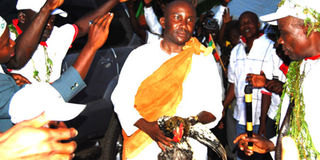The crowning of a Bwamba king

Omudhingiya Martin Ayongi Kamya is welcomed in Bundibugyo District recently. He was recently recognised by the state and crowned. PHOTOs by Ruth katusabe
What you need to know:
The coronation of the Obudhingya bwa Bwamba (cultural institution of Bwamba) in Bundibugyo District last month marked its secession from the Rwenzururu Kingdom. But what are the rituals followed before one is crowned king in this new institution?
An elephant, cocoa, plantain (Gonja), two spears, a mountain and a drum constitute the cultural emblem of their kingdom. Their king, referred to as Omudhingiya, carries the title of Enjoghu Ya Bwamba, literally meaning the elephant of Bwamba (Bundibugyo). The Obudhingiya Bwa Bwamba (OBB) is the newest cultural institution, comprising the Bamba, Babwisi and Bavonama from Bundibudyo District and parts of Democratic Republic of Congo. Their leader, Omudhingiya Martin Ayongi Kamya, was recently recognised by the state and crowned.
“The elephant can’t fail to pass anywhere in the jungle or water. It is energetic and attracts tourists and that is our king,” says Baker Bamwendere, the OBB minister of Culture while describing of the reverence with which the king is held. The spear given to the king has a bell and symbolises security, while the drum is for the purposes of communication to his subjects.
“The king’s spear has three parts, the apex, locally called Tung, the middle (Kidhidho) and lower part (Oruhoso),” Bamwendere says, and explains that the apex is dressed with a bell and skin of a wild cat.
The skin of the wild cat symbolises authority and power. Cocoa symbolises wealth because it is the key cash crop in Bundibugyo District and has brought wealth in the area. The king is greeted by his subjects chanting “Yela yela yela” by raising and shaking hands up and down several times. This greeting gives respect and honour to the king.
The cultural dresses for important cultural days include backcloth, plant leaves around the head and waist, and tunic (kanzu) with the kingdom emblem.
Some of the rituals before one is crowned king
The night before coronation day, the king to be is taken through several rituals by the elders inside the shrine at the palace. “These rituals are strictly attended by the elders from the 25 clans that form the kingdom but not the public and start at 10pm up to 5am,” Bamwendere says.
The fiercest ritual is where the prospective king has to spear a live buffalo inside the palace.
“A buffalo is captured and tied inside the palace and the king to be must spear it. After this function, the leader to be is dressed in a black cloth and made to sit down on a seat called Kigone. Spearing the buffalo dead means that the king is brave,” says Bamwendere adding, “It is the same spear given to him permanently by the elders as part of his instruments of power.”
After the buffalo is killed, its meat is roasted and served to the elders.
A seat that was historically for the cultural head is usually placed in the shelter called Kitubi-kyagana where family members converge and the cultural head sits to chair a meeting.
“Martin Kamya, sitting on this seat served his ancestors the cock, pounded plantain (gonja) and blood from a goat that was slaughtered as the elders kept singing through the process and dancing the Makhu dance,” Bamwendere explained.
The next morning, the rituals are performed in broad day light and the public is allowed to attend. The king is given instruments of power by the three ethnic cultural leaders from Bamba, Babwisi and Bavonoma.




